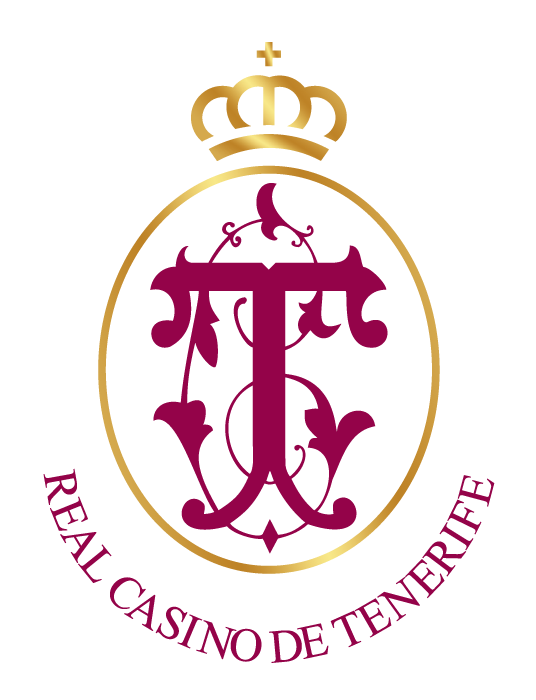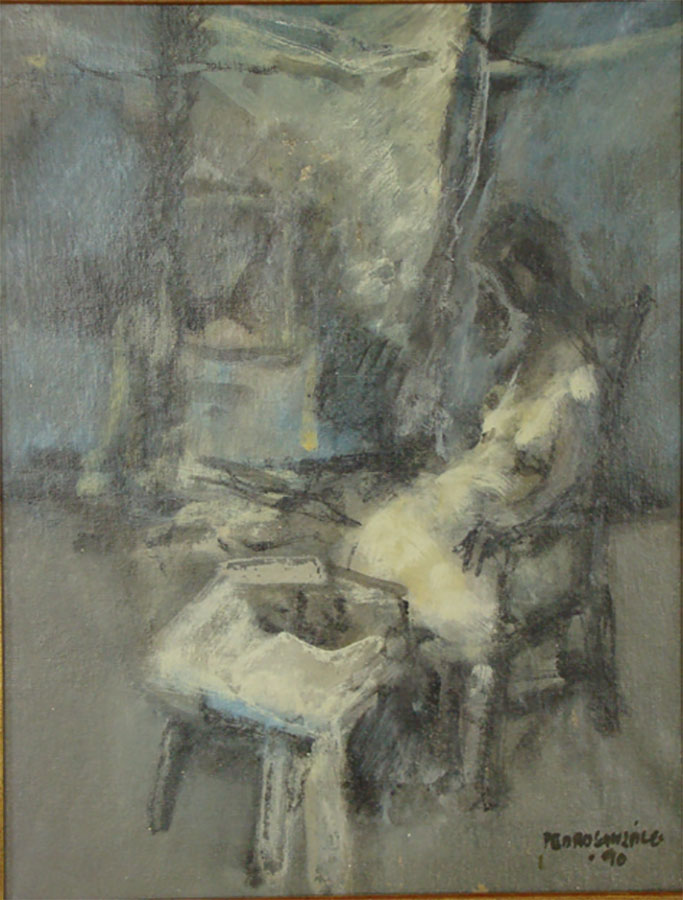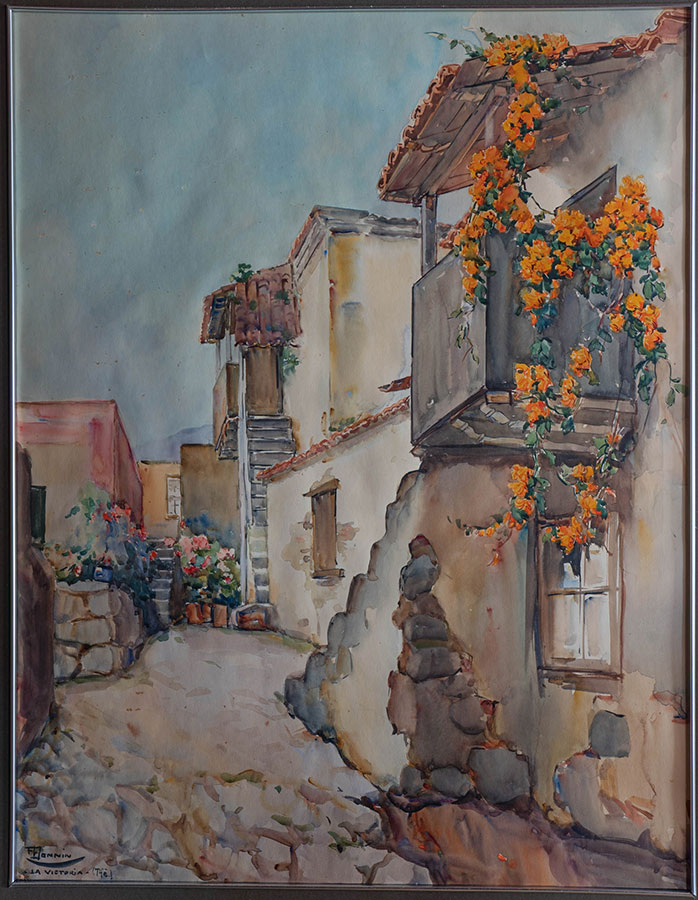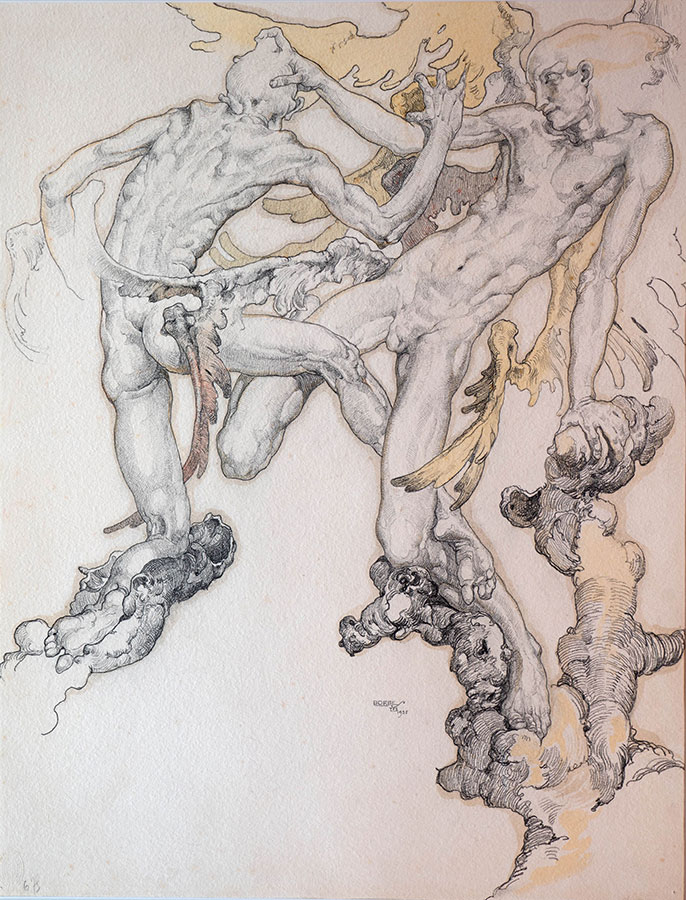
- Type of work: Sculpture
- Technique: Stone carving
- Approximate dimensions: 205 x 64 x 50 cm
- Theme: Allegorical
- Title: Allegory of the Sea
- Author: Francisco Borges Salas (1901-1994)
- Chronology or Year: 1935
- Historical-artistic analysis:
Style: Following the regionalist tendency of the moment, within a realism there is a stylistic mixture of a schematic classical language with a certain expressionist vision, to which are added symbolist elements.
Description: A full-bodied female nude, with her arms falling along her body, is presented standing upright on a plinth, holding in her right hand a conch shell, the only symbolic detail alluding to the allegory of the sea, an element to which Borges resorts, together with the earth, for the representation of the Islands in the two sculptures commissioned for the decoration of the main hall of the Casino in 1934. Unlike in La Tierra, a long hair crowns her head, endowing the figure, of full and rounded forms, with a certain staticism, timelessness and sensuality.
Observations: The work was commissioned, along with the Earth, by contract dated May 15, 1934 signed by Borges Salas and the then president of the Casino, Faustino Martín Albertos. It specifies the size and material of the sculptures (2 meters in Almarquir stone, executed in a single block), which should be two female nudes, whose sketch needed to have the approval of the Board before its final execution. Likewise, the execution time was set at two years and the payment of the order was determined at 15,000 pesetas, distributed in different installments. Together with a series of vases, the two sculptures were intended to decorate the main hall. His nudity attracted attention, to the point that in 1943, on the occasion of the presence in the mentioned stay of the Captain General of the Canary Islands, Francisco García Escámez e Iniesta with the first authorities of the Island, among which were the Bishop Fray Albino González, the President of the Cabildo, Francisco La Roche Aguilar, the President of the Audiencia, Luis Vallejo Quero, the Deputy Provincial Chief of the Movement, Joaquín Amigó Lara and Colonel Lorenzo Machado Méndez y Fernández de Lugo, the President of the Audiencia, Luis Vallejo Quero, the Deputy Provincial Chief of the Movement Joaquín Amigó de Lara and Colonel Lorenzo Machado Méndez y Fernández de Lugo, then President of the Casino and host of the event, the censorship of the time tried to cover the bodies of the sculptures, which was opposed by the Board of Directors.
About the author: Francisco Borges Salas (Santa Cruz de Tenerife 1901 – 1994), began his training at the School of Arts and Crafts in his hometown where he received drawing classes from Pedro Tarquis Soria, being his first teacher in sculpture Guzman Companys in his studio in La Laguna. In 1920 he went to Madrid where he continued his apprenticeship with Victorio Macho (1887-1966), interrupted in 1921 by the need to fulfill his Military Service, participating in the war of Africa with the 64th Infantry Regiment. In 1925 he travels to Paris where he attends the workshop of Antoine Bourdelle (1861 – 1929) and comes in contact with the artistic world of the time: Dali, Picasso, Oscar Dominguez, Isadora Duncan, etc. On his return to Tenerife in 1930, he obtained the position of professor of drawing at the School of Arts and Crafts and developed a great creative work both in sculpture and painting, participating in the Venice Biennial in 1936 and making wood carvings for the Quinta Canaria in Havana, the busts of Dr. Zerolo and José Tabares Bartlet in La Laguna and the sculptural group of the Fecundidad in the García Sanabria Park in 1938. For political reasons he was dismissed from his teaching post in 1937, which led him to self-exile in Venezuela, together with his brother Miguel and their respective families, where he arrived in December 1941 and remained until 1962. There he worked for ten years at the head of the design and propaganda department of the Ministry of Health, winning in 1950 the international competition for the decoration of the Assembly Hall of the Military Academy of Caracas, with five oil paintings on the country’s heroes and military campaigns. On his return to his homeland, in 1972 he became a full member of the Royal Academy of Fine Arts of San Miguel Arcángel, holding an anthological exhibition in the Sala de la Caja Canarias in La Laguna in 1973. In 1983 the Círculo de Amistad XII de Enero organized another exhibition and in 1988 the Viceconsejería de Cultura y Deportes del Gobierno de Canarias, as part of “Maestros del siglo XX” organized another anthological exhibition, presented in the two Canary capitals and curated by Eliseo Izquierdo. In 1993 he received the Gold Medal of the Canary Islands and the appointment of Favorite Son of Santa Cruz de Tenerife; a year before an exhibition in honor of the artist was held at the Círculo de Amistad XII de Enero.
Bibliography:
Archive of the Casino de Tenerife
Valeriano WEYLER: The small history of a great casino (The one in Santa Cruz de Tenerife). Santa Cruz de Tenerife, 1964.
Agustín GUIMERÁ RAVINA, Alberto DARIAS PRÍNCIPE: El Casino de Tenerife 1840 – 1990, Santa Cruz de Tenerife, 1992.
Carlos PÉREZ REYES: Contemporary Canarian sculpture (1918 – 1978). Island Council of Gran Canaria. Las Palmas de Gran Canaria, 1984. http://www,spanishprintmakers.com/spanish/borges2.htm.26/04/2009 http://www.sociedadcentroicodense.com/html/galeria-artistas-borges.html. 26/04/2009
Eliseo IZQUIERDO PÉREZ: “Borges Salas, Francisco” in Gran Enciclopedia Canaria. Ediciones Canarias. Santa Cruz de Tenerife, 1994,p.638 (T.III)




